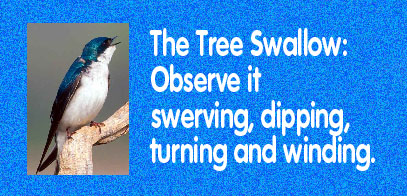This season's articles (Excerpted from our printed newsletter):
The Tree Swallow
The Tree Swallow is a migratory bird, migrating in large flocks by day and roosting at night. During the day they can also be seen flying in circular motions, turning and winding in all directions and skimming over meadows, streets, and cities. In flight this bird can be confused with the Purple Martin.
 Tree Swallows have steel blue backs with green reflections and underparts almost a pure white or clear. They have a slightly forked tail and light brown feet. There are no distinguishing marks between the male and female other than the females are slightly duller in color. Juveniles are a dull gray-brown, tail and wings are slate brown with a slight greenish tint. This adult bird is 5.25-6 inches in length with a wingspan of 12-13 inches.
Tree Swallows have steel blue backs with green reflections and underparts almost a pure white or clear. They have a slightly forked tail and light brown feet. There are no distinguishing marks between the male and female other than the females are slightly duller in color. Juveniles are a dull gray-brown, tail and wings are slate brown with a slight greenish tint. This adult bird is 5.25-6 inches in length with a wingspan of 12-13 inches.
The preferred habitat is open space such as the edges of woods and areas near water including marshes, shorelines, and swamps. They are aerial feeders, foraging over land and water, swerving and dipping to feed on flying insects such as beetles, midges, crane flies, horseflies, ants, moths, grasshoppers, dragonflies, and mayflies. In winter they feed on seed and berries, bayberries being a favorite.
The Tree Swallow prefers a natural tree cavity but will nest in man-made nestboxes and eaves of barns. During breeding season these swallows are territorial and aggressively defend their nests against other Tree Swallows and against other species. They are solitary nesters but may nest in loose aggregations with nests 10-15 meters from one another. They frequently compete for nest sites with House Wrens, House Sparrows, and Bluebirds. The nest is built by the female in a globular form constructed of grasses and straw, lined with feathers of various kinds. Throughout the months of April to June, as many as 4-6 white eggs are laid. Incubation is performed by both parents and they take anywhere from 13-16 days to hatch.
Feeder Frenzy: Tube Feeders
Tube feeders are long, slender containers, usually suspended from a tree or hung from a pole. These may have either tiny openings to dispense Nyjer seed or larger holes for sunflower or a mix.
Upside-down feeders, which are tubes with perches above the feeding holes, are made specifically for the acrobatic goldfinches that have no problem eating head down.
Most tube feeders have separate perches far enough apart to reduce some of the competition that often occurs around the feeding station. These feeders are preferred by perching birds, especially chickadees, titmice, pine siskens, grosbeaks, finches, nuthatches, and sparrows. Add a tray to the bottom and you'll see blue jays, cardinals, grackles, and doves.
Many models adapt for cages to be put around them to prevent the larger birds or mammals from visiting. Some tube feeders are designed for peanuts, having larger holes, some have "socks" attached to the bottom for more nyjer availability. These feeders can be made of metal, plastic, ceramic, or glass. The designs and sizes are practical to decorative.
All feeders should be cleaned regularly. An absence of birds might mean the seed may have gotten wet or old. If, when filling the tube feeder, you just add new seed to the top, you may have spoiled seed on the bottom. Come in and ask Mike how to properly refill tube feeders.
Back to current newsletter













